- Table of Content
- 1.A work in prog...
- 2.International ...
- 3.PROBA2 Observa...
- 4.Geomagnetic Ob...
- 5.Review of Iono...
- 6.The SIDC Space...
- 7.STCE Activitie...
2. International Sunspot Number by SILSO
3. PROBA2 Observations
4. Geomagnetic Observations in Belgium
5. Review of Ionospheric Activity
6. The SIDC Space Weather Briefing
7. STCE Activities
A work in progress
Active region NOAA 3559 started to rotate over the Sun's northeast limb on 17 January as a simple bipolar region. The sunspot group started to develop from 20 January onwards, with sunspots forming in its southern and trailing (eastern) portion. The metamorphosis can be observed in the white light imagery underneath (SDO/HMI - http://sdo.gsfc.nasa.gov/data/aiahmi/ ) covering the period from 19 January until early 22 January. The sunspot area of this region nearly doubled in barely 48 hours, to twice the total surface area of the Earth.
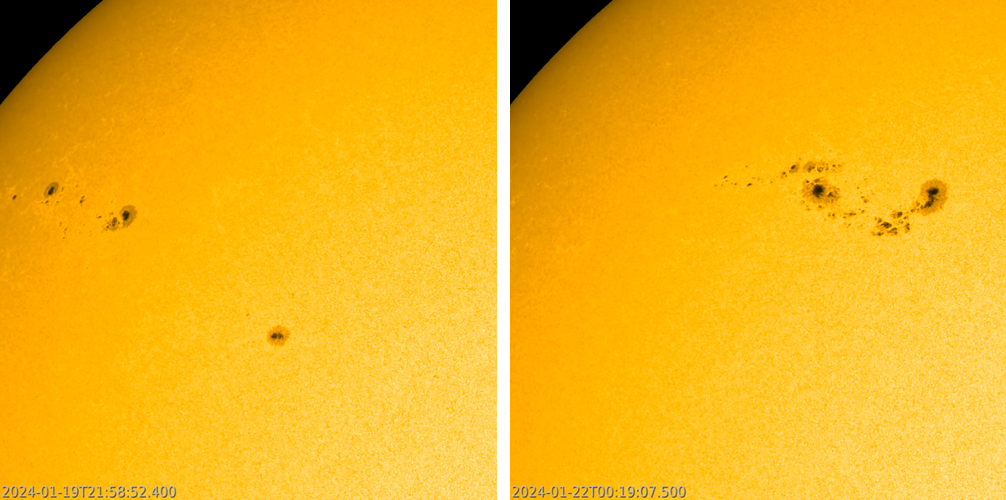
The increased activity was also observed in a steady rise of the background x-ray flux, with gradually also more and stronger flaring from NOAA 3559. Note one needs imagery in extreme ultraviolet, x-rays, or H-alpha to link each of the flaring spikes to the source region on the Sun. NOAA 3559 produced its first M-class flare early on 22 January, an M1.5 flare peaking at 06:22 UTC. The greater than 10 MeV proton flux is also gradually increasing towards event threshold of 10 pfu (particle flux units), being near 6 pfu around noon on 22 January. Its start predates the M-class flare and is most likely related to flaring activity from NOAA 3559 that happened during the second half of 21 January (or other activity...). The evolution of the GOES x-ray and the proton flux over the last 7 days can be seen in the graphs underneath, resp. the top and bottom chart. Also the 10.7 cm radio flux, as measured by Penticton (Canada - https://www.spaceweather.gc.ca/forecast-prevision/solar-solaire/solarflux/sx-5-flux-en.php), showed an important increase from 157 sfu (solar flux units) on 19 January to almost 180 sfu on 21 January.
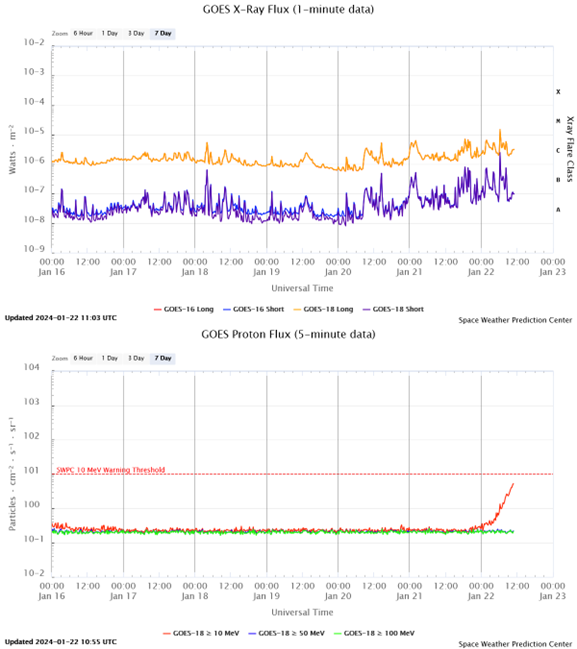
The image underneath shows a captivating C5 flare generated by NOAA 3559 early on 21 January. It was one of the first somewhat stronger C-class flares produced by this region. The imagery were obtained by SDO/AIA 094 showing the Sun at multi-million degrees. Clips are available in the online version of this article at https://www.sidc.be/index.php/article/work-progress It's virtually certain that the increasing size and complexity of NOAA 3559 will drive strong solar activity over the coming days.

International Sunspot Number by SILSO
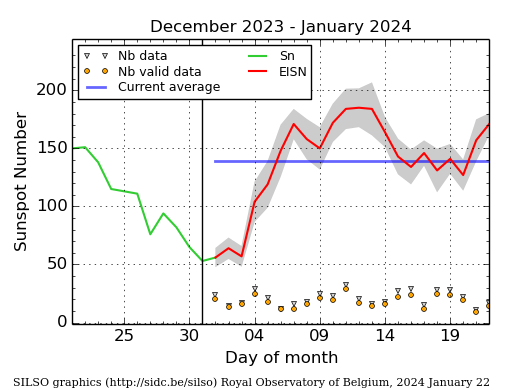
The daily Estimated International Sunspot Number (EISN, red curve with shaded error) derived by a simplified method from real-time data from the worldwide SILSO network. It extends the official Sunspot Number from the full processing of the preceding month (green line), a few days more than one solar rotation. The horizontal blue line shows the current monthly average. The yellow dots give the number of stations that provided valid data. Valid data are used to calculate the EISN. The triangle gives the number of stations providing data. When a triangle and a yellow dot coincide, it means that all the data is used to calculate the EISN of that day.
PROBA2 Observations
Solar Activity
Solar flare activity was low during the week.
In order to view the activity of this week in more detail, we suggest to go to the following website from which all the daily (normal and difference) movies can be accessed: https://proba2.oma.be/ssa
This page also lists the recorded flaring events.
A weekly overview movie (SWAP week 721) can be found here: https://proba2.sidc.be/swap/data/mpg/movies/weekly_movies/weekly_movie_2024_01_15.mp4.
Details about some of this week's events can be found further below.
If any of the linked movies are unavailable they can be found in the P2SC movie repository here: https://proba2.oma.be/swap/data/mpg/movies/.
Thursday January 18
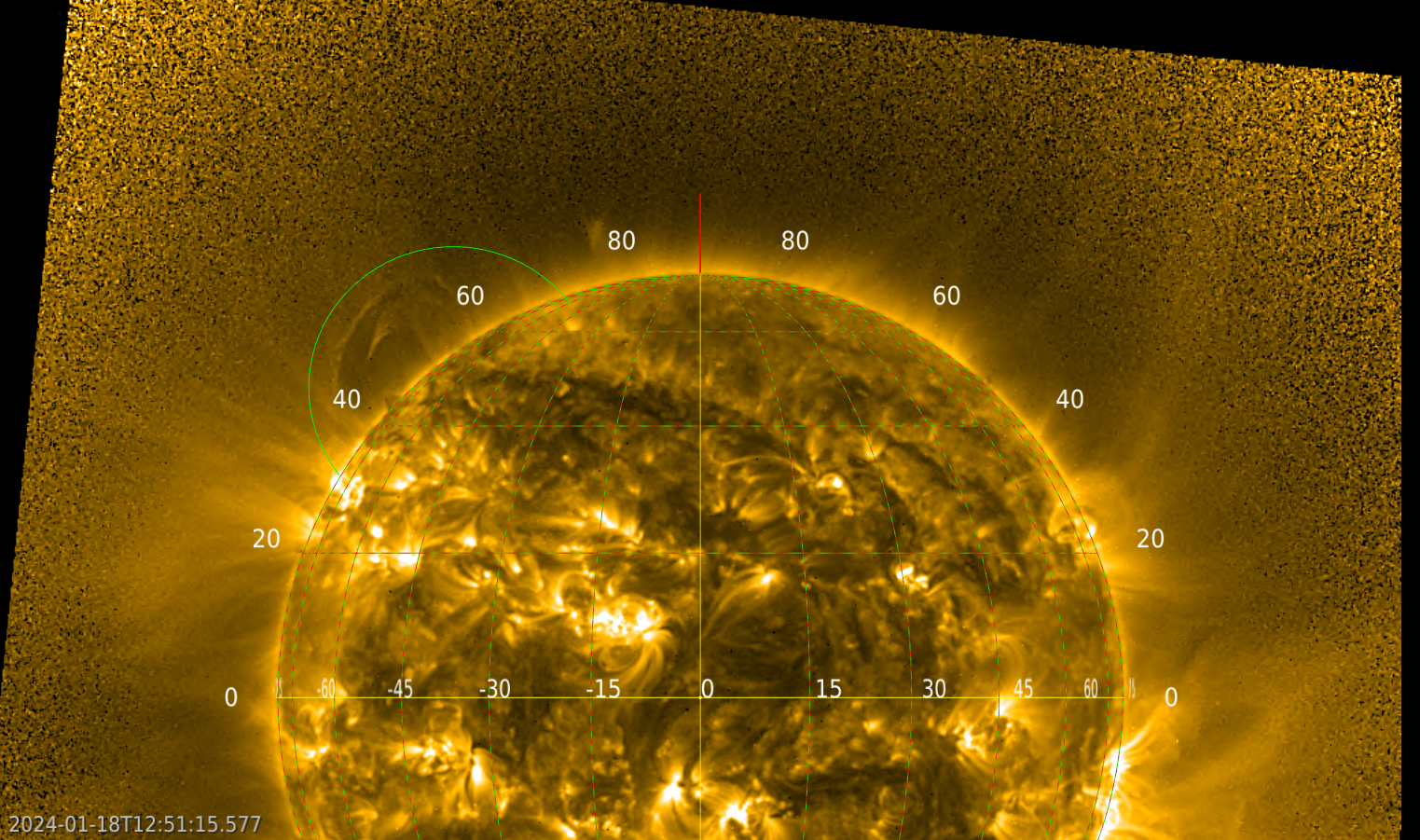
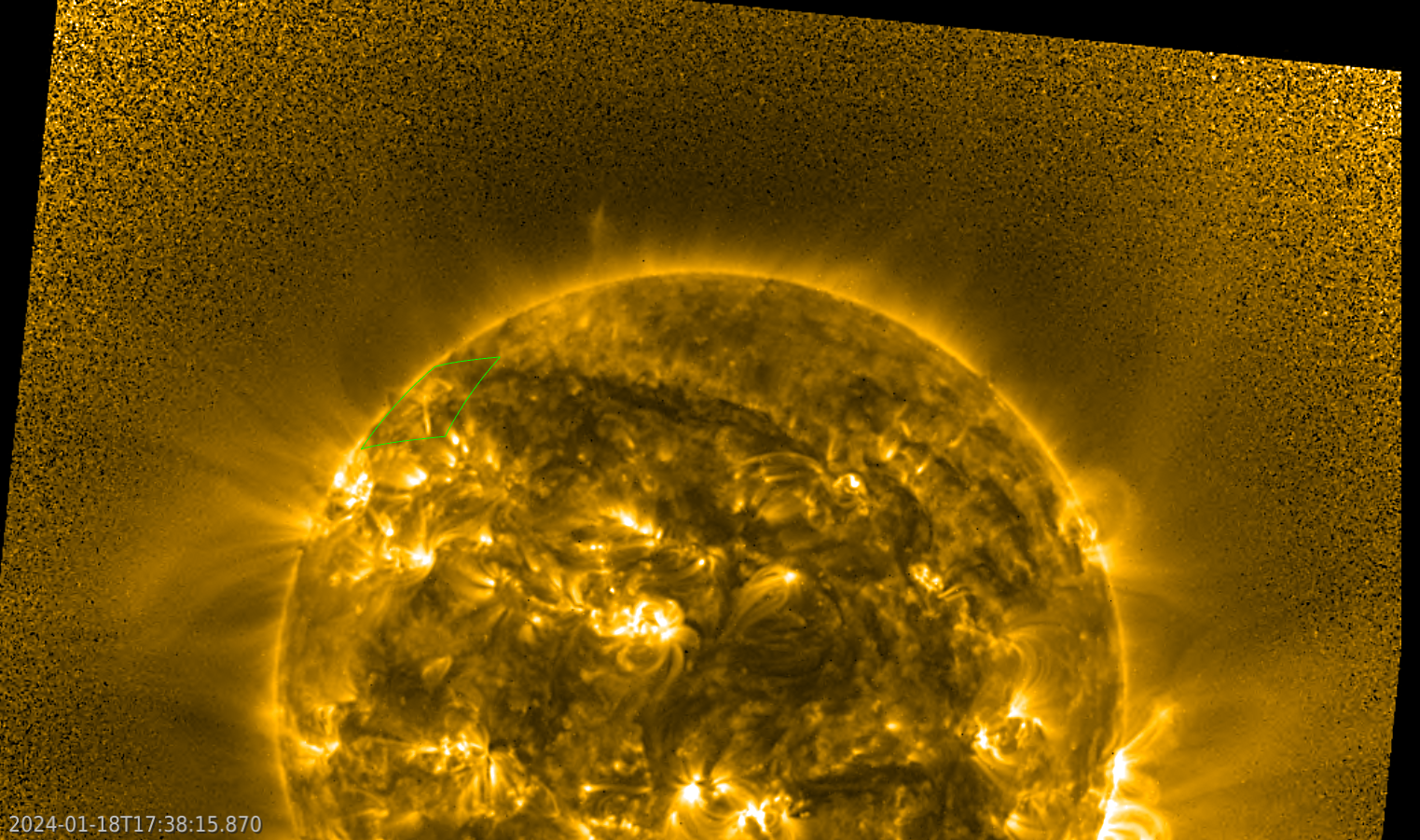
No major flares were recorded this week, so the solar activity was dominated by filament/prominence eruptions. The SWAP images above show observations of one of the filament eruptions of this week (top panel, encircled in green), occurring on 18 January 2024. It originated from the north-eastern quadrant, between NOAA active regions 3556 and 3559. The bottom panel shows the post-eruptive arcades, highlighted by the green rectangle.
Find a SWAP movie of the event here: https://proba2.sidc.be/swap/movies/20240118_swap_movie.mp4.
Geomagnetic Observations in Belgium
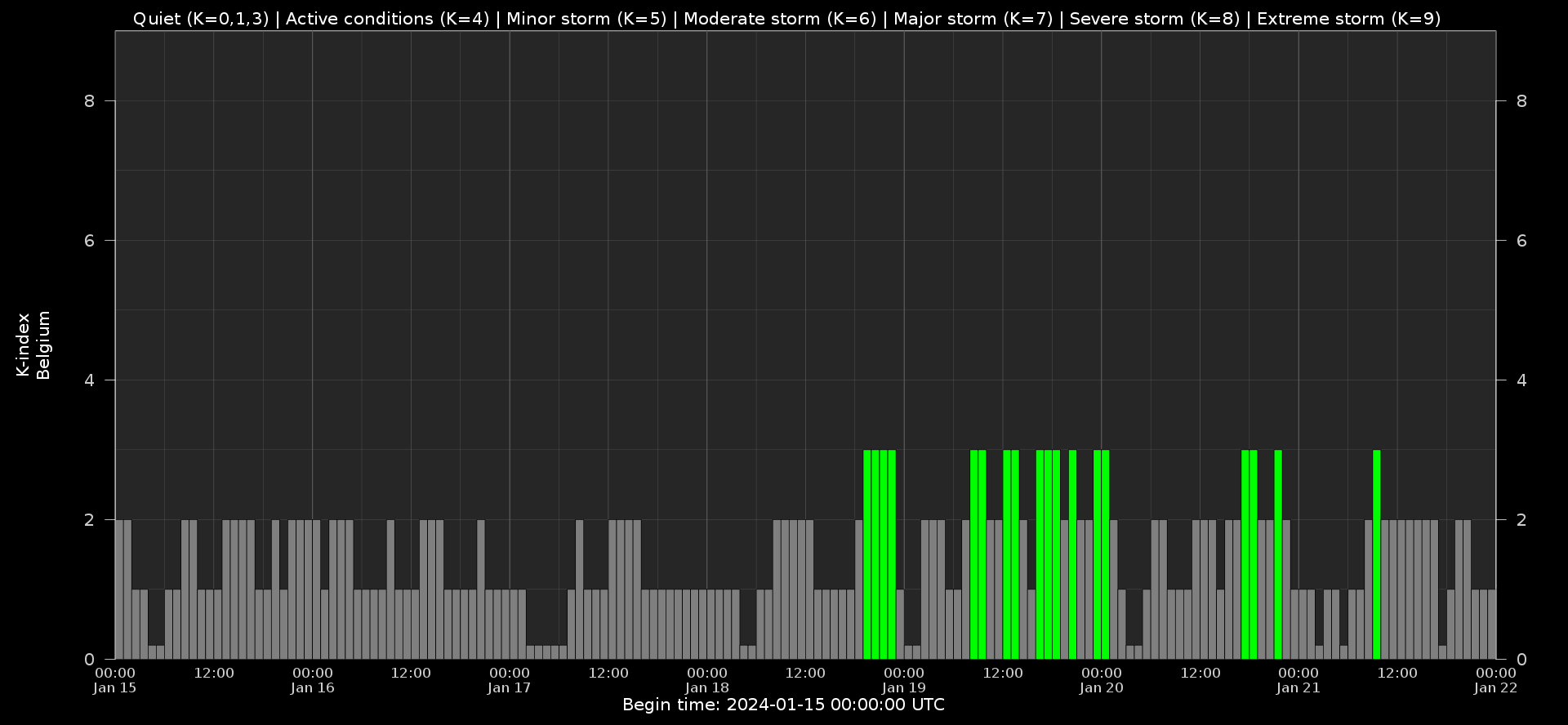
Local K-type magnetic activity index for Belgium based on data from Dourbes (DOU) and Manhay (MAB). Comparing the data from both measurement stations allows to reliably remove outliers from the magnetic data. At the same time the operational service availability is improved: whenever data from one observatory is not available, the single-station index obtained from the other can be used as a fallback system.
Both the two-station index and the single station indices are available here: http://ionosphere.meteo.be/geomagnetism/K_BEL/
Review of Ionospheric Activity
NEW! The time series below illustrates (in green) the VTEC deviation from normal quiet behaviour.
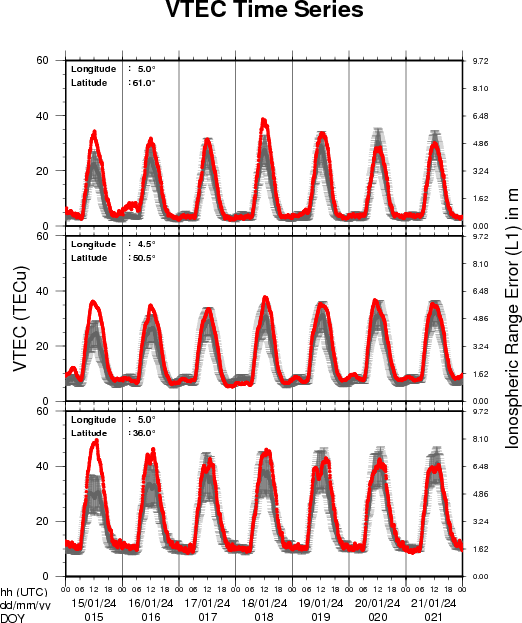
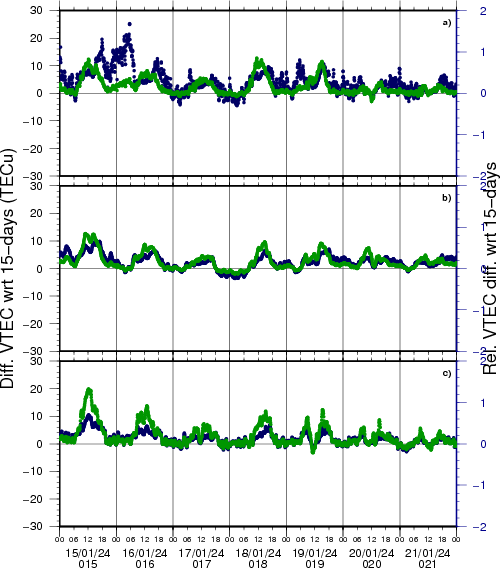
VTEC time series at 3 locations in Europe from 15 Jan 2024 till 21 Jan 2024
The top figure shows the time evolution of the Vertical Total Electron Content (VTEC) (in red) during the last week at three locations:
a) in the northern part of Europe(N 61deg E 5deg)
b) above Brussels(N 50.5deg, E 4.5 deg)
c) in the southern part of Europe(N 36 deg, E 5deg)
This top figure also shows (in grey) the normal ionospheric behaviour expected based on the median VTEC from the 15 previous days.
The time series below shows the VTEC difference (in green) and relative difference (in blue) with respect to the median of the last 15 days in the North, Mid (above Brussels) and South of Europe. It thus illustrates the VTEC deviation from normal quiet behaviour.
The VTEC is expressed in TECu (with TECu=10^16 electrons per square meter) and is directly related to the signal propagation delay due to the ionosphere (in figure: delay on GPS L1 frequency).
The Sun's radiation ionizes the Earth's upper atmosphere, the ionosphere, located from about 60km to 1000km above the Earth's surface.The ionization process in the ionosphere produces ions and free electrons. These electrons perturb the propagation of the GNSS (Global Navigation Satellite System) signals by inducing a so-called ionospheric delay.
See http://stce.be/newsletter/GNSS_final.pdf for some more explanations; for more information, see https://gnss.be/SpaceWeather
The SIDC Space Weather Briefing
The Space Weather Briefing presented by the forecaster on duty from to January 15 to 21. It reflects in images and graphs what is written in the space weather report: https://www.stce.be/briefings/20240122_SWbriefing.pdf

If you need to access the movies, contact us: stce_coordination at stce.be
STCE Activities
Check out our activity calendar: activities and encounters with the Sun-Space-Earth system and Space Weather as the main theme. We provide occasions to get submerged in our world through educational, informative and instructive activities.
If you want your event in our calendar, contact us: stce_coordination at stce.be
* Jan 22-24, 2024, STCE Space Weather Introductory Course, Brussels, Belgium - Registrations are open on https://www.stce.be/
* Jan 25, 2024, post-Space Weather Introductory Course, by JMG and MeteoWing, Brussels, Belgium - registration is included in the Jan SWIC
* Jan 30, 2024, public lecture on solar observations from ground, Urania, Hove, Belgium
* Feb 2, 2024, 15u - STCE Seminar, Identifying and Tracking Coronal Flux Ropes in Magnetic Field Simulations by Andreas Wagner, Brussels, Belgium
* Mar 4-5, 2024, STCE Space Weather Introductory Course, focus on aviation, online - Registrations are open on https://www.stce.be/
* Apr 22-24, 2024, STCE Space Weather Introductory Course, Brussels, Belgium - Registrations are open on https://www.stce.be/
More info needed? Contact us: stce_coordination at stce.be
Check: https://www.stce.be/calendar
